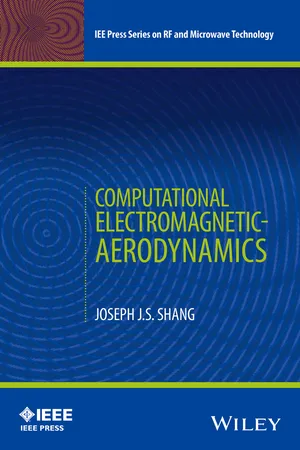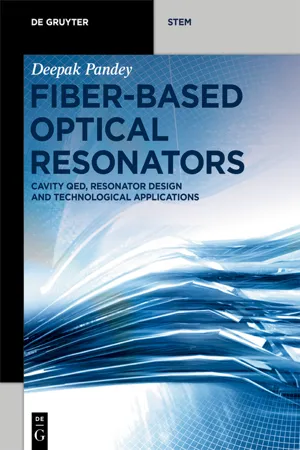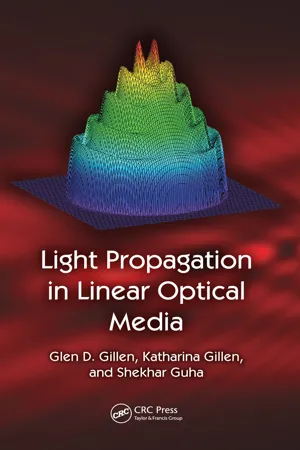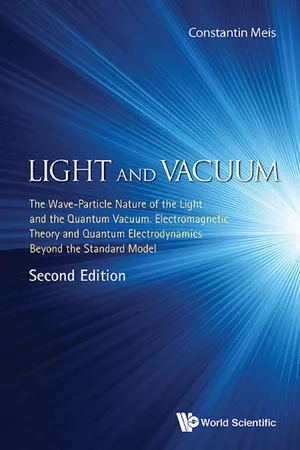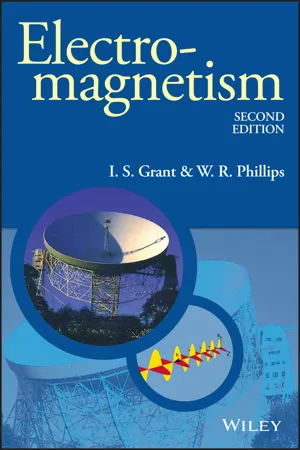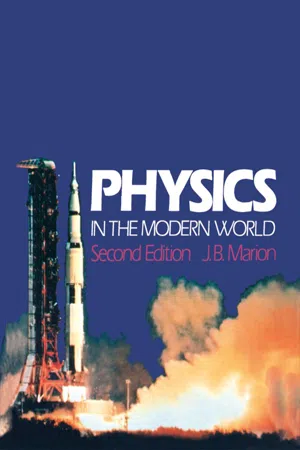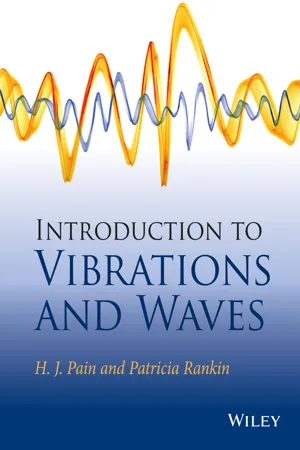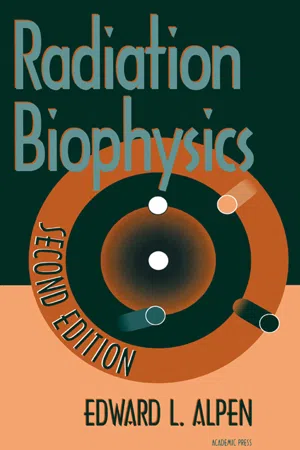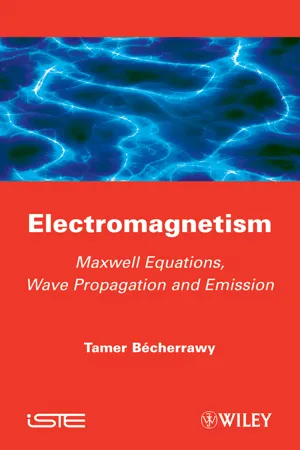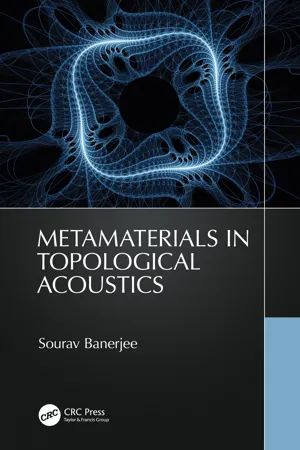Physics
Electromagnetic Waves in a Vacuum
Electromagnetic waves in a vacuum are transverse waves that consist of oscillating electric and magnetic fields. They do not require a medium to propagate and travel at the speed of light. These waves have a wide range of frequencies, from radio waves to gamma rays, and play a fundamental role in various phenomena, including light, radiation, and wireless communication.
Written by Perlego with AI-assistance
Related key terms
Related key terms
1 of 4
Related key terms
1 of 3
12 Key excerpts on "Electromagnetic Waves in a Vacuum"
- eBook - ePub
- Joseph J. S. Shang(Author)
- 2016(Publication Date)
- Wiley-IEEE Press(Publisher)
CHAPTER 5 Electromagnetic Wave Propagation and Scattering Introduction An electromagnetic wave is a transverse wave and is generated by electric charge excitation. The wave is associated with synchronized electric and magnetic fields that oscillate perpendicularly to each other. The direction of wave propagation is perpendicular to the direction of energy transfer. In free space, its phase velocity has a constant value of speed of light. According to the Maxwell equations, a spatially varying electric field is directly linked to a temporally varying magnetic field. Conversely, the magnetic field change in space is associated with an altered electric field in time. It is important to know that the electric and magnetic fields are vibrating orthogonally from each other in phase but both reaching maxima and minima at the same points in place. The coexisting fields occur simultaneously and are linked by the theory of special relativity. In fact, the magnetic field is considered as a relativistic distortion of the electric field. The wave speed is the product of wavelength and frequency, u = f λ. For practical purposes, the electromagnetic spectrum is divided into radio waves, microwaves, infrared, visible light, ultraviolet, x-rays, and gamma rays. The very long wavelength of radio wave is in the tens of meters and the very short wavelength gamma ray is smaller than an atomic nucleus. The solutions to the Maxwell electromagnetic wave equations have often been classified as the plane waves and spherical waves (Jordan, 1960). The former is not but a limiting case of the latter at a very large distance from the source of the wave generator. Like all waves, an electromagnetic wave can be constructed by any number of monochromatic wave components with a single frequency, amplitude, and phase - eBook - ePub
Fiber-Based Optical Resonators
Cavity QED, Resonator Design and Technological Applications
- Deepak Pandey(Author)
- 2024(Publication Date)
- De Gruyter(Publisher)
This equation highlights that electromagnetic waves travel at the speed of light. The electromagnetic spectrum encompasses a wide range of frequencies and wavelengths, including radio waves, microwaves, infrared waves, visible light, ultraviolet waves, X-rays, and Gamma rays. Each segment of the spectrum corresponds to a different range of frequencies and wavelengths, with visible light being the portion that can be detected by the human eye. As shown in Figure 1.4, the electric field vector E and magnetic field vector B are orthogonal to the wave propagation direction and their amplitudes sinusoidally vary in space and time. This description of EM-wave directly arises from the four fundamental laws of electromagnetism. They describe a deeper connection between the following four basic quantities of electromagnetism [ 3 ]: Displacement vector inside a medium D = ϵ 0 E + P Magnetization vector B = μ 0 (H + M) Charge density ρ Current density J = σ E where P and M are defined as the polarizability and the magnetization and are related to electric and magnetic fields via electric (χ e) and magnetic susceptibility (χ m), respectively. (1.4) P = ϵ 0 χ e E ; M = χ m H Note that with equation (1.4), Displacement and magnetization vectors can also be written in terms of vacuum and relative permittivity and permeability,. respectively, (1.5) D = ϵ 0 (1 + χ e) E = ϵ 0 ϵ r E (1.6) B = μ 0 (1 + χ m) H = μ 0 μ r E where ϵ r = 1 + χ e is the relative permittivity and μ r = 1 + χ m is the relative permeability. Figure 1.4 Electromagnetic wave propagation in a vacuum can be considered as oscillating electric and magnetic fields with a given amplitude in two orthogonal axes and perpendicular to the propagation axis. Maxwell’s equation establishes relations between four quantities D, B, ρ and J - Tamer Bécherrawy(Author)
- 2013(Publication Date)
- Wiley-ISTE(Publisher)
Chapter 6Electromagnetic WavesA remarkable property of Maxwell’s equations (that was not possible to foresee before the formulation of the electromagnetic theory) is that they have solutions representing electromagnetic waves propagating at the speed of light in matter and in vacuum. The existence of these waves was experimentally confirmed, in 1890 by Hertz, who succeeded in producing them and verifying that they have the same propagation, interference, diffraction and polarization properties as light waves. Thus, Maxwell theory has enabled us to understand the nature of light as electromagnetic waves with very short wavelengths. Actually, we can produce and detect electromagnetic waves of frequencies varying between 10−2 Hz and 1032 Hz, that is, of wavelengths varying between 1010 m and 10−24 m. They play a very important part in nearly all branches of physics and have a considerable impact on economic, social, political and intellectual life. In this chapter, we recall the principal results of the electromagnetic theory, namely Maxwell’s equations. We discuss their wave solution and some applications of electromagnetic waves.6.1. Principal results of the electromagnetic theory
The basic concepts of the electromagnetic theory are the electric field E and the magnetic induction field B (also called magnetic field for short) defined by their action on a charge q of velocity v[6.1]In the presence of dielectrics, we also have to introduce the electric displacement (also called electric induction ) D = εo E + P where εo = 8.8541878 x10−12 A2 s4 /kg.m3is the electric permittivity of vacuum and P is the density of polarization (or simply polarization ), i.e. the electric dipole moment of the dielectric per unit volume. In the presence of magnetic materials, we also have to introduce the magnetic field strength (also called magnetic intensity ) H = B/µo - M where µo = µo = 4π x 10−7 kg.m/A2 s2 is the magnetic permeability of vacuum and M is the intensity of magnetization (or simply magnetization- eBook - ePub
- Glen D. Gillen, Katharina Gillen, Shekhar Guha(Authors)
- 2017(Publication Date)
- CRC Press(Publisher)
2 Electromagnetic Waves in Linear MediaIn this chapter we present mathematical models describing the vector electric and magnetic fields for light propagating within a linear medium. Mathematical models presented cover:To simplify the mathematics for this chapter, we place the following restrictions on the propagation of the light through the medium:- General forms for Maxwell's equations and the wave equation
- Maxwell's Equations for source- free media
- Maxwell's equations for vacuum
- Polarized light fields
- the volume through which the light is propagating is composed of only a single medium
- the medium’s electric permittivity, ∈, and magnetic permeability, µ , are both constants
- there are no boundary conditions for the volume, nor diffractive or spatially limiting elements within the volume
2.1 Maxwell's Equations in Linear Media
As discussed in Sections 1.2–1.4, when electromagnetic waves propagate through a medium other than a vacuum the electrodynamic properties of the medium must be taken into consideration. Here, we will assume that the medium can have any one, two, or all three of the following properties:- the electric field of the EM wave, Ẽ , induces a dipole moment per unit volume, P ˜, within the medium,
- the magnetic field of the EM wave, induces a magnetic moment per unit volume,H ,˜M ˜, within the medium, or
- the medium can have free charges per unit volume, or a free charge density, ρ .
The response of the medium to the incident electromagnetic fields can either be a linear response or a nonlinear response. In general, the magnitude of the induced polarization in the medium, P - eBook - ePub
Light And Vacuum: The Wave-particle Nature Of The Light And The Quantum Vacuum. Electromagnetic Theory And Quantum Electrodynamics Beyond The Standard Model (Second Edition)
The Wave–Particle Nature of the Light and the Quantum Vacuum. Electromagnetic Theory and Quantum Electrodynamics Beyond the Standard Model
- Constantin Meis(Author)
- 2017(Publication Date)
- WSPC(Publisher)
−3 .3.6.Conclusion Remarks
The principal conclusion that can be drawn out from the last chapter is that the electromagnetic waves can propagate in vacuum and the propagation equations are immediately deduced from Maxwell’s equations.However, in Maxwell’s theory the vacuum itself is not a completely empty medium but has an electromagnetic nature, processing a magnetic permeability µ0 = 4π × 10 −7 H m−1 and an electric permittivity , and consequently an impendence of a precise value, .The vacuum intrinsic electric and magnetic properties play a crucial role in Maxwell’s equations whatever the system of units used (SI or CGS) because they fix, the speed c of the electromagnetic waves in vacuum , which at the present status of knowledge is considered to be the highest speed permitted in the universe.Furthermore, it is important to note that the energy density and flux of the electromagnetic waves depend equally on the vacuum properties ε0 and µ0 .It turns out that the electromagnetic waves, in other words light, appear to behave as a natural vibration of the vacuum, having intrinsic electric and magnetic properties. The vector potential of the electromagnetic field, issued from Maxwell’s equations is proportional to the angular frequency.On the other hand, it is of high interest to note the volume importance for the existence of a “mode” of the electromagnetic field, issued from the guided propagation studies. All the cut-off wave-lengths calculated for the different shapes of waveguides entail that longer wavelengths beyond those values cannot stand within a volume of a given shape and dimensions. Consequently, an electromagnetic wave mode of a given wavelength, even the simplest one composed by a single state, cannot subsist in a volume whose dimensions correspond to a smaller cut-off wavelength. The characteristic volume corresponding to a single mode of the electromagnetic field is inversely proportional to the cube of the angular frequency. - eBook - ePub
- I. S. Grant, W. R. Phillips(Authors)
- 2013(Publication Date)
- Wiley(Publisher)
CHAPTER 11
Electromagnetic waves
We have already outlined in section 10.4 how a spark discharge can produce changing electric and magnetic fields that propagate outwards from the changing charge and current distributions in the spark. Any charge distribution which changes with time, or any varying current, can give rise to a radiated electromagnetic field. However it is only when the changes are rapid that the radiated fields are large enough to carry away an appreciable fraction of the power dissipated in the system. In practice radiated fields associated with varying currents are usually unimportant unless the variations contain frequencies higher than 100 kHz. This is about the lowest frequency used for commercial transmission of radio waves.In this chapter we will consider some general properties of electromagnetic waves propagating in free space or in homogeneous isotropic media. We will also consider what happens to simple waves at a plane boundary between two media. The electromagnetic field will be treated classically. This means that we will assume the energy in the waves to be distributed continuously throughout the space occupied by them, and the energy to depend in some way on the macroscopic fields E, D, B and H. The same approach was adopted in the discussion of the energies in static electric and magnetic fields. The media in which the waves are travelling will also be treated classically, as if they were continuous, and will be characterized by macroscopic quantities such as relative permittivity ε , relative permeability μ , and electrical conductivity σ . These quantities vary with frequency, although the electrical conductivity of almost all substances is effectively constant for most frequencies that we will consider. The interpretation of the parameters ε , μ and σ throws much light on the microscopic description of matter, but these problems will rarely be mentioned in this chapter. The classical theory provides a good description of most electromagnetic phenomena for frequencies below about 1011 - eBook - ePub
- Jerry Marion(Author)
- 2012(Publication Date)
- Academic Press(Publisher)
transverse waves. (The electromagnetic field cannot support longitudinal waves.)A comparison of mechanical and electromagnetic waves is given in Table 14-1 .TABLE 14-1 COMPARISON OF MECHANICAL AND ELECTROMAGNETIC WAVESMECHANICAL WAVES ELECTROMAGNETIC WAVES Can be either transverse (for example, waves on a string) or longitudinal (for example, sound waves). Always transverse. Propagate by means of interactions among material particles. Can propagate through vacuum. Propagate with various speeds depending on the type of wave and the medium. Always propagate with the speed of light. (In different materials, the speed of light is less than the speed in vacuum, 3 × 108 m/s.) Characterized by the regular variation of a single quantity (for example, the density of air for sound waves or the amplitude of the vibrating particles for waves on a string). Characterized by the regular variation of two quantities, E and B . Carry energy and momentum. Carry energy and momentum. Receiving an Electromagnetic Signal
A radio transmitter impresses a signal on an electromagnetic wave by varying the frequency and the magnitude of the current flow in the antenna. The signal is then carried through space by the wave. How do we extract the signal from the wave at the receiving end? The procedure is essentially the reverse of that used at the transmitter. Figure 14-6 shows a receiving antenna which is identical to the transmitting antenna pictured in Fig. 14-2 - eBook - ePub
- H. John Pain, Patricia Rankin(Authors)
- 2015(Publication Date)
- Wiley(Publisher)
9 Electromagnetic WavesIntroduction
Earlier chapters have shown that the velocity of waves through a medium is determined by the inertia and the elasticity of the medium. These two properties are capable of storing wave energy in the medium, and in the absence of energy dissipation they also determine the impedance presented by the medium to the waves. In addition, when there is no loss mechanism a pure wave equation with a sine or cosine solution will always be obtained, but this equation will be modified by any resistive or loss term to give an oscillatory solution which decays with time or distance.These physical processes describe exactly the propagation of electromagnetic waves through a medium. The magnetic inertia of the medium, as in the case of the transmission line, is provided by the inductive property of the medium, i.e. the permeability μ, which has the units of henries per metre. The elasticity or capacitive property of the medium is provided by the permittivity ε, with units of farads per metre. The storage of magnetic energy arises through the permeability μ; the potential or electric field energy is stored through the permittivity ε.If the material is defined as a dielectric, only μ and ε are effective and a pure wave equation for both the magnetic field vector H and the electric field vector E will result. If the medium is a conductor, having conductivity σ (the inverse of resistivity) with dimensions of siemens per metre or (ohm m)–1 , in addition to μ and ε, then some of the wave energy will be dissipated and absorption will take place.In this chapter we will consider first the propagation of electromagnetic waves in a medium characterized by μ and ε only, and then treat the general case of a medium having μ, ε and σ properties.9.1 Maxwell’s Equations
Electromagnetic waves arise whenever an electric charge changes its velocity. Electrons moving from a higher to a lower energy level in an atom will radiate a wave of a particular frequency and wavelength. A very hot ionized gas consisting of charged particles will radiate waves over a continuous spectrum as the paths of individual particles are curved in mutual collisions. This radiation is called ‘Bremsstrahlung’. The radiation of electromagnetic waves from an aerial is due to the oscillatory motion of charges in an alternating current flowing in the aerial. - eBook - ePub
- Edward L. Alpen(Author)
- 1997(Publication Date)
- Academic Press(Publisher)
From Maxwell’s findings, a generalization could be made that electromagnetic waves are known to be energy propagated through space and that one of the simplest models for this generation is an oscillating electric charge. For example, an electron oscillating in a linear path will produce time varying electric and magnetic fields that are propagated through space and that constitute an electromagnetic wave front. The new theories also suggested that there was no limit to the frequencies that could be generated, nor was there any inherent limit to the distance that these waves could propagate. Indeed, the theories predicted the existence of radio waves before they were produced and measured.Electromagnetic waves exist in a continuous spectrum that extends over many decades of frequency and that includes radiations from the lowest frequencies (radio waves) to the highest (X-rays and gamma rays). Of principal interest for this text are the X-rays and gamma rays, which have sufficient energy to ionize atoms with which they interact. They are therefore called ionizing radiations . Figure 2.1 outlines the principal regions of the electromagnetic spectrum and highlights the region of ionizing radiation frequencies.Figure 2.1 Spectrum of electromagnetic radiations.From Fig. 2.1 , the regular relationship between the frequency, v , and the wavelength, λ, is easily observable. The product of the frequency and the wavelength is a constant equal to the speed of light,(2.2)The speed of light in a vacuum (and in air) is 2.998 × 108 m s−1 (for simplicity, 3 × 108 m s−1 ).The relationship between frequency or wavelength and the energy of the radiation is not as obvious as the simple relationship between frequency and wavelength. A theoretical explanation for cavity radiation remained an unsolved problem for many years. Wein proposed a formula for spectral radiance of cavity radiators, but his formulation contained arbitrary constants and was only a moderately good fit to the actual data. In the very early 1900s, Planck (1901) , who was pursuing further development of Wien’s formula, suggested a radical departure for the physics of his time. Planck proposed a simple modification of Wien’s formulation that was a better fit to the data, but was, after all, still empirical and required fitting arbitrary constants. He went on to seek a more satisfactory theorem, based on atomic theory as it was then known. He assumed that the atoms constituting the radiating surface of the cavity were electromagnetic oscillators with characteristic frequencies and that these oscillators would absorb and emit electromagnetic radiation from and to the cavity. He further proposed that these electromagnetic oscillators were constrained to certain energy levels; that is, the oscillators could not have any energy, but were constrained to energies that were defined by his new formula. In effect he proposed a quantum theory - eBook - ePub
Electromagnetism
Maxwell Equations, Wave Propagation and Emission
- Tamer Becherrawy(Author)
- 2013(Publication Date)
- Wiley-ISTE(Publisher)
10.10. Electromagnetic spectrumAn electromagnetic wave carries energy; thus, it cannot be emitted by charges at rest or in uniform motion: only accelerated charges (or variable currents) may emit them. If the current is a simple harmonic function of time, the emitted wave is simple harmonic of equal frequency. The emitter of a wavelength λ is always a system whose dimensions are comparable to λ. For instance, waves of wavelengths roughly more than 1 mm are emitted by macroscopic systems (electronic or electric).While propagating, an electromagnetic wave is subject to the various effects due to the propagation medium and eventual obstacles. The most important effects are the decrease of intensity with the travelled distance like 1/r 2 (in the case of a spherical wave), reflection on surfaces of large dimensions compared to the wavelength, diffraction by apertures and obstacles of dimensions comparable to λ, absorption by the medium, etc.The most important applications of electromagnetic waves are in the domain of telecommunications. Information (sound, image, etc.) may be transmitted by modulated waves , that is, of amplitude, frequency or phase that vary according to the information. Modulation is realized by using an input transducer , which transforms the information into an electric signal. Microphones and photoelectric cells are examples of input transducers. In the receiver, an output transducer transforms the electrical signal of the modulated wave into a non-electrical signal. A loudspeaker and a liquid crystal screen are examples of output transducers. The extracted signal reproduces the original one with some deformation depending on the quality of the system.The following is a classification of electromagnetic waves according to their frequency (or their wavelength λ = c / ) and some of their principal uses.1) Waves of industrial frequencies (30 Hz < < 3 kHz and 105 m < λ < 107 - eBook - ePub
- Sourav Banerjee(Author)
- 2023(Publication Date)
- CRC Press(Publisher)
Understanding of electromagnetic waves is the key to the study of photonics. In this chapter electromagnetic wave equation is derived from the fundamentals. The electromagnetic wave equation is solved from the fundamentals, comparing the wave equations for acoustics and electromagnetic waves simultaneously. Phonons in acoustics and elastodynamics are equivalent to the photons in electrodynamics. The comparison is presented for equivalent application of phononics in acoustic metamaterials in a later chapter. Understanding of electromagnetic waves and its equivalency helps understand the fundamentals of quantum mechanics discussed in this book.REFERENCES
- Forbes, N ., Mahon, B., Faraday, Maxwell, and the Electromagnetic Field: How Two Men Revolutionized Physics . 2014, Amherst, New York: Prometheus Book.
- Fitzpatrick, R ., Maxwell’s Equations and the Principles of Electromagnetism . 2008, Jones & Bartlett Learning. 2008-01-22: https://www.jblearning.com/ .
- Gonzalez, G ., Advanced Electromagnetic Wave Propagation Methods . 2021, Boca Raton, FL: CRC Press.
- Feynman, R.P ., Quantum Electrodynamics . 1971, Boca Raton, FL: CRC Press.
- Greiner, W ., Schramm, S., Stein, E., Bromley, D.A., Quantum Chromodynamics
- eBook - ePub
Making Physics Fun
Key Concepts, Classroom Activities, and Everyday Examples, Grades K?8
- Robert Prigo(Author)
- 2015(Publication Date)
- Skyhorse(Publisher)
So the particle picture of light was back on the scene. Indeed, the nature of light turned out to be much more interesting than an either-or particle or wave reality. Both descriptions are needed for a full picture of light. This complementary picture is known as the wave-particle duality for light. The dual nature of light, propagating as an electromagnetic wave while interacting with matter through particle-like photons, sums up our present understanding of light. This wave-particle duality is now known to be a universal property of nature. Based on an analogy with the dual nature of light, Louis de Broglie (1892–1987) proposed that matter itself (electrons, atoms, etc.) might show the same duality. He proposed that particles such as electrons might have wave-like features. His ideas were soon put to the test and vindicated when experiments revealed the diffraction and superposition of electrons! All forms of light, both visible and nonvisible, share many fascinating characteristics and properties. Light does not need a medium through which to propagate. It can propagate in a vacuum. Light is made up of oscillating and self-sustaining electric and magnetic fields that interact with matter in a particle-like way (photons). Light travels at a constant speed in a vacuum (299,792,458 meters per second). In a transparent material, light travels at a slower speed, with different frequencies traveling at slightly different speeds. In a vacuum and in uniform transparent materials, light travels in straight lines. Some objects reflect light, some absorb light, and some do both. Light bends— refracts —when it propagates from one transparent medium into another. Visible light comes in a narrow but continuous spectrum of frequencies that we detect as different colors (red to violet). “White” light is composed of light of different colors (red to violet). “Black” is the absence of light
Index pages curate the most relevant extracts from our library of academic textbooks. They’ve been created using an in-house natural language model (NLM), each adding context and meaning to key research topics.
Explore more topic indexes
Explore more topic indexes
1 of 6
Explore more topic indexes
1 of 4
